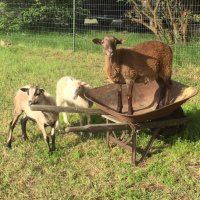soarwitheagles
True BYH Addict
I am a sheep newbie and not so sure what and how to feed the sheep. In fact, I will write a new post in this section, asking for help.
Right now, we are daily feeding unlimited hay [dried grass I believe], 3-4 times a week we feed the sheep grain from our local mill, then I have been cutting the newly planted pasture and feeding the sheep a daily combo of fresh cut mixture of clover, brom, rye, chicory, turnip tops, birdsfoot trefoil, etc.
It's a lot of work!
I would like to turn them out to pasture and let them do all the hard work. So next week, I will begin the wonderful task of installing 2,000 feet of woven wire and T-posts to make these so called paddocks.
Sure hope it works!
Soar
Right now, we are daily feeding unlimited hay [dried grass I believe], 3-4 times a week we feed the sheep grain from our local mill, then I have been cutting the newly planted pasture and feeding the sheep a daily combo of fresh cut mixture of clover, brom, rye, chicory, turnip tops, birdsfoot trefoil, etc.
It's a lot of work!
I would like to turn them out to pasture and let them do all the hard work. So next week, I will begin the wonderful task of installing 2,000 feet of woven wire and T-posts to make these so called paddocks.
Sure hope it works!
Soar

